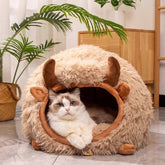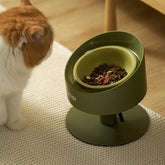Why Do Cats Have Whiskers?

Have you ever wondered why cats have whiskers? Whiskers are an interesting feature that is unique to cats and serve as one of their main sensory tools. They give cats an edge over their prey. Whiskers are generally found on the sides of a cat's nose, allowing them to use them to see if they can fit through small spaces. This blog is all about why cats have whiskers and how they can help you better understand your feline friend.
What Are Cat Whiskers?
Cat whiskers, also known as vibrissae, are specialized hairs that are deeply embedded in their body and connected to the muscular and nervous system, this allows whiskers to send sensory messages to the brain. They are long, stiff, and touch-sensitive, providing cats with important information about their environment, such as detecting obstacles and prey. Whiskers allows cats to be savvy explorers!
Mystacial whiskers are the longest of the facial vibrissae, and cats usually have 24 on each cheek. While some cats may have fewer than 24, the total number should always be even. In order for a cat to get a good sense of the environment, it is important that its whiskers are distributed symmetrically on either side of its face.

What Do Cat Whiskers Do?
Balance the body
Whiskers play an important role in a cat's balance and body awareness. The proprioceptors located at the ends of the whiskers send messages to the brain about the body's position, which helps the cat maintain balance and coordination and land on their feet.
As radar sensors
Cats use their whiskers as radar sensors to gather information about their surroundings. As a result, they are highly sensitive to vibrations and changes in air currents, which alert them to prey, obstacles, or other objects in their path. Further, whiskers help cats navigate in low-light conditions. As a result, cats keep balance and avoids collisions using these sensory cues.

Convey emotions
It is also important to note that whiskers are a part of feline body language and communication. Various emotions can be conveyed by the position of a cat's whiskers, including happiness, curiosity, fear, and aggression. As an example, a contented cat will have relaxed whiskers, while an alert or fearful cat will have tense and forward-facing whiskers. You can learn about a cat's mood by observing its whiskers and other body language cues.
The whiskers act as protectors
Their sensitivity helps cats avoid obstacles, injuries, and other hazards in their environment. The whiskers also help cats navigate tight spaces and determine if they can fit through small openings, helping to keep them safe from getting stuck or trapped. In this way, whiskers play a crucial role in a cat's survival and well-being.

How To Protect Your Cat’s Whiskers
Cats have sensitive whiskers that can experience "whisker stress" from narrow food/water bowls, which can cause fatigue to the tactile hairs. To avoid this, use a wider bowl.
The whiskers on a cat's body shed like other hairs. However, you should never trim them. Cut whiskers can cause cats to become disoriented and scared.
There's nothing wrong with whiskers shedding but excessive loss or breakage may indicate a medical issue. If noticed, contact a vet. Treating the medical issue can allow whiskers to regrow. In some cases, whiskers may be clipped or removed as part of medical treatment, but they will grow backas long as the follicle is not damaged. It may take 6 weeks to 3 months for facial whiskers to regrow. Color change of regrown whiskers (e.g. from white to black) is normal and does not affect their function.

Knowing more about your cat's whiskers can help you to better understand your cat and how to care for them. By taking the time to learn about your cat, you can give them the love and care that they deserve.























